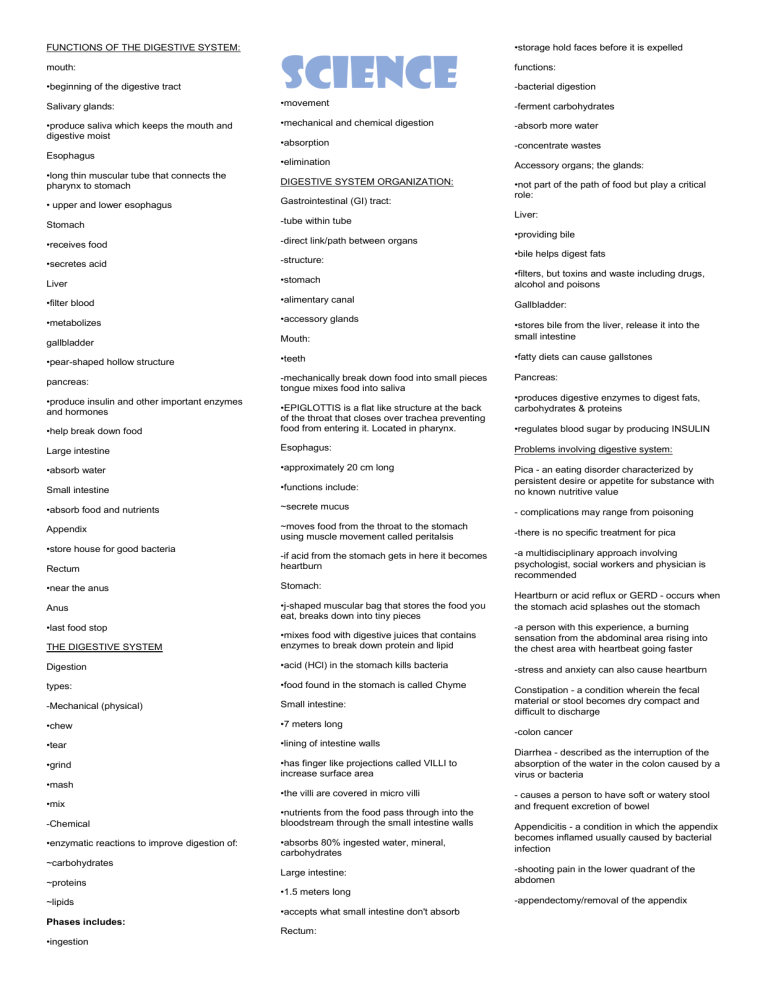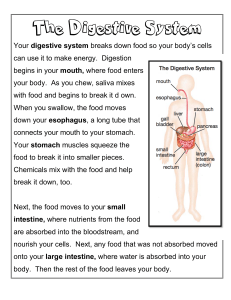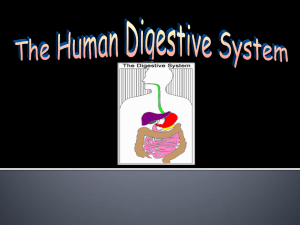Digestive System Overview: Functions, Organs, and Problems
advertisement

•storage hold faces before it is expelled FUNCTIONS OF THE DIGESTIVE SYSTEM: mouth: •beginning of the digestive tract Salivary glands: •produce saliva which keeps the mouth and digestive moist Esophagus Science functions: -bacterial digestion •movement -ferment carbohydrates •mechanical and chemical digestion -absorb more water •absorption -concentrate wastes •elimination Accessory organs; the glands: •long thin muscular tube that connects the pharynx to stomach DIGESTIVE SYSTEM ORGANIZATION: • upper and lower esophagus Gastrointestinal (GI) tract: Stomach -tube within tube •receives food -direct link/path between organs •secretes acid -structure: Liver •stomach •filter blood •alimentary canal •metabolizes •accessory glands gallbladder Mouth: •stores bile from the liver, release it into the small intestine •pear-shaped hollow structure •teeth •fatty diets can cause gallstones pancreas: -mechanically break down food into small pieces tongue mixes food into saliva Pancreas: •produce insulin and other important enzymes and hormones •not part of the path of food but play a critical role: Liver: •providing bile •bile helps digest fats •filters, but toxins and waste including drugs, alcohol and poisons Gallbladder: •produces digestive enzymes to digest fats, carbohydrates & proteins •help break down food •EPIGLOTTIS is a flat like structure at the back of the throat that closes over trachea preventing food from entering it. Located in pharynx. Large intestine Esophagus: Problems involving digestive system: •absorb water •approximately 20 cm long Small intestine •functions include: Pica - an eating disorder characterized by persistent desire or appetite for substance with no known nutritive value •absorb food and nutrients ~secrete mucus Appendix ~moves food from the throat to the stomach using muscle movement called peritalsis -there is no specific treatment for pica Rectum -if acid from the stomach gets in here it becomes heartburn -a multidisciplinary approach involving psychologist, social workers and physician is recommended •near the anus Stomach: Anus •j-shaped muscular bag that stores the food you eat, breaks down into tiny pieces •store house for good bacteria •last food stop •regulates blood sugar by producing INSULIN - complications may range from poisoning Heartburn or acid reflux or GERD - occurs when the stomach acid splashes out the stomach THE DIGESTIVE SYSTEM •mixes food with digestive juices that contains enzymes to break down protein and lipid -a person with this experience, a burning sensation from the abdominal area rising into the chest area with heartbeat going faster Digestion •acid (HCl) in the stomach kills bacteria -stress and anxiety can also cause heartburn types: •food found in the stomach is called Chyme -Mechanical (physical) Small intestine: •chew •7 meters long •tear •lining of intestine walls •grind •has finger like projections called VILLI to increase surface area •mash •mix -Chemical •enzymatic reactions to improve digestion of: •the villi are covered in micro villi •nutrients from the food pass through into the bloodstream through the small intestine walls •absorbs 80% ingested water, mineral, carbohydrates ~carbohydrates Large intestine: ~proteins ~lipids -colon cancer Diarrhea - described as the interruption of the absorption of the water in the colon caused by a virus or bacteria - causes a person to have soft or watery stool and frequent excretion of bowel Appendicitis - a condition in which the appendix becomes inflamed usually caused by bacterial infection -shooting pain in the lower quadrant of the abdomen •1.5 meters long -appendectomy/removal of the appendix •accepts what small intestine don't absorb Phases includes: Rectum: •ingestion Constipation - a condition wherein the fecal material or stool becomes dry compact and difficult to discharge






